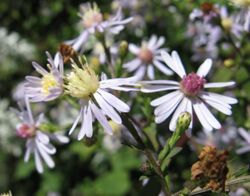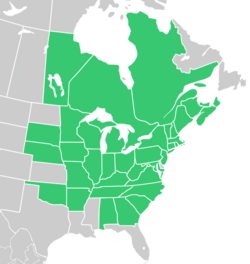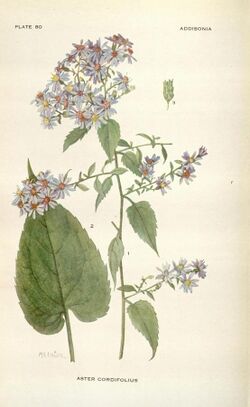Biology:Symphyotrichum cordifolium
| Symphyotrichum cordifolium | |
|---|---|

| |
| Heartleaf aster | |
| Scientific classification | |
| Kingdom: | Plantae |
| Clade: | Tracheophytes |
| Clade: | Angiosperms |
| Clade: | Eudicots |
| Clade: | Asterids |
| Order: | Asterales |
| Family: | Asteraceae |
| Tribe: | Astereae |
| Subtribe: | Symphyotrichinae |
| Genus: | Symphyotrichum |
| Subgenus: | Symphyotrichum subg. Symphyotrichum |
| Section: | Symphyotrichum sect. Symphyotrichum |
| Species: | S. cordifolium
|
| Binomial name | |
| Symphyotrichum cordifolium | |

| |
| Native distribution[2] | |
| Synonyms[2] | |
|
Basionym
Alphabetical list
| |
Symphyotrichum cordifolium (formerly Aster cordifolius), commonly known as common blue wood aster, heartleaf aster,[3] and blue wood-aster,[4] is a perennial herbaceous flowering plant in the family Asteraceae native to central and eastern North America. It reaches heights of up to 1.2 meters (4 feet) and has bluish daisy-like flowers which bloom late-summer and fall in its range.
Description
Symphyotrichum cordifolium reaches heights of up to 1.2 meters (4 feet). The lower leaves are heart-shaped, while leaves higher on the stem tend to be sessile with more rounded bases. The composite flowers, which have bluish to rarely white ray florets and light yellow disc florets that eventually turn purple, emerge in August and persist into October.[3]
Chromosomes
S. cordifolium has a chromosome base number of x = 8. Diploid and tetraploid cytotypes with respective counts of 16 and 32 have been reported.[3]
Taxonomy
Symphyotrichum cordifolium is classified in the subgenus Symphyotrichum, section Symphyotrichum.[5] The species was first formally described by Carl Linnaeus in 1753 as Aster cordifolius.[6]
Hybrids
Where the range of Symphyotrichum cordifolium overlaps with that of S. puniceum, the F1 hybrid named Symphyotrichum × tardiflorum can occur. Symphyotrichum × schistosum is the hybrid of S. cordifolium and S. laeve var. laeve.[3]
A hybrid of S. cordifolium and S. shortii may occur, and this has been named Symphyotrichum × finkii. Hybrids with S. drummondii and S. urophyllum have been reported but not confirmed.[3]
Distribution and habitat
Symphyotrichum cordifolium occurs from Manitoba, east to Nova Scotia and Maine, south to Georgia and Alabama, and west to Oklahoma. It was once introduced in British Columbia but did not persist.[3] It is an introduced species in Great Britain and Norway .[2]
It grows primarily in mesic sites with soils that are rocky to loamy but generally rich, at heights ranging from sea level along the coastal plain up to 1,200 m (3,900 ft) in the Appalachian Mountains. It can be found on open wooded slopes, along the banks of streams, on moist ledges, in swampy woods, along the borders of beech–maple forests and oak–hickory forests, as well as in clearings, thickets, and along roadsides and ditches. It also can be found in urban areas where it is sometimes considered a weed species.[3]
Ecology
Reproduction
Symphyotrichum cordifolium reproduces vegetatively via short rhizomes, as well as via wind-dispersed seeds. The ray florets of species in the Symphyotrichum genus are exclusively female, each having a pistil but no stamen, while disk florets are bisexual, each with both male and female reproductive parts.[7]
Pests and diseases

Two rusts have been recorded on S. cordifolium: the brown rust Puccinia dioicae and the red rust Coleosporium asterum.[8]
Conservation
Symphyotrichum cordifolium has coefficients of conservatism (C-values) in the Floristic Quality Assessment (FQA) that range from 2 to 8 depending on evaluation region.[9] The lower the C-value, the higher tolerance the species has for disturbance and the lesser the likelihood that it is growing in a presettlement natural community.[10] In the Dakotas, for example, S. cordifolium has a C-value of 8, meaning its populations there are found in high-quality remnant natural areas with little environmental degradation but can tolerate some periodic disturbance.[11] In contrast, in the Laurentian plains and hills of Maine and New Brunswick, it has been given a C-value of 2, meaning its presence in locations of that ecoregion provides little confidence of a remnant habitat.[12]
(As of July 2021), NatureServe listed Symphyotrichum cordifolium as Secure (G5) worldwide, Critically Imperiled (S1) in Kansas , and Vulnerable (S3) in Delaware and Missouri.[1]
Uses
Medicinal
The Ojibwe have used S. cordifolium to make an incense to attract deer.[13]
Gardening
Symphyotrichum cordifolium is cultivated as a garden plant under its current name and the older name Aster cordifolius. Several cultivars have been selected for garden use, and the following have achieved the Royal Horticultural Society's Award of Garden Merit:[14]
- 'Chieftain' has "light mauve-blue ray florets."[15]
- 'Little Carlow' (S. cordifolium hybrid) with "abundant violet-blue" rays.[16]
- ‘Photograph’ (S. cordifolium hybrid) has "pale lilac-blue flowers."[17]
- 'Sweet Lavender' with "lavender-blue flowers."[18]
Citations
- ↑ 1.0 1.1 NatureServe 2021.
- ↑ 2.0 2.1 2.2 2.3 POWO 2019.
- ↑ 3.0 3.1 3.2 3.3 3.4 3.5 3.6 Brouillet et al. 2006a.
- ↑ BSBI 2007.
- ↑ Semple 2021.
- ↑ IPNI 2021.
- ↑ Brouillet et al. 2006b.
- ↑ Wilhelm & Rericha 2017, p. 1098.
- ↑ Freyman 2021.
- ↑ Rothrock 2004, p. 3.
- ↑ Northern Great Plains Floristic Quality Assessment Panel 2017.
- ↑ Cameron & Faber-Langendoen 2018.
- ↑ Smith 1932.
- ↑ Royal Horticultural Society 2020.
- ↑ Royal Horticultural Society n.d.a.
- ↑ Royal Horticultural Society n.d.b.
- ↑ Royal Horticultural Society n.d.c.
- ↑ Royal Horticultural Society n.d.d.
References
- Flora of North America Editorial Committee, ed. (2006a), "Symphyotrichum cordifolium", Flora of North America North of Mexico (FNA), 20, New York and Oxford, http://www.efloras.org/florataxon.aspx?flora_id=1&taxon_id=250067634, retrieved 4 July 2021
- Flora of North America Editorial Committee, ed. (2006b), "Symphyotrichum", Flora of North America North of Mexico (FNA), 20, New York and Oxford, http://www.efloras.org/florataxon.aspx?flora_id=1&taxon_id=132022, retrieved 24 July 2021
- Template:Cite BSBI 2007
- Cameron, D.; ((Faber-Langendoen)), D. (2018). "Database of coefficients of conservatism for Omernik Level 3 Ecoregion 82 (Maine/New Brunswick Plains and Hills 8.1.8)". Chicago: Openlands. https://universalfqa.org/view_database/134/.
- Freyman, W.A. (2021). "Universal FQA". Chicago: Openlands. https://universalfqa.org/. "Choose 'FQA Databases', then 'Compare Species Coefficients', then enter search term 'Symphyotrichum cordifolium'."
- "Aster cordifolius L.". International Plant Names Index (IPNI). Royal Botanic Gardens, Kew. 2021. https://www.ipni.org/n/309934-2.
- "Symphyotrichum cordifolium Heartleaf Aster". Arlington, Virginia. 2 July 2021. https://explorer.natureserve.org/Taxon/ELEMENT_GLOBAL.2.158910/Symphyotrichum_cordifolium.
- "Dakotas, 2017 [updated from Coefficients of conservatism for the vascular flora of the Dakotas and adjacent grasslands; U.S. Geological Survey, Biological Resources Division, Information and Technology Report USGS/BRD/ITR-2001-0001"]. Chicago: Openlands. 2017. https://universalfqa.org/view_database/81/. "Updated the nomenclature by comparing to ITIS on the 2001 list and removed duplicates."
- "Symphyotrichum cordifolium (L.) G.L.Nesom". Royal Botanic Gardens, Kew. 2019. http://powo.science.kew.org/taxon/urn:lsid:ipni.org:names:981790-1.
- Rothrock, P.E. (June 2004). Floristic quality assessment in Indiana: the concept, use, and development of coefficients of conservatism. Final report for ARN A305-4-53, EPA Wetland Program Development Grant CD975586-01. (Report). Indianapolis: Indiana Department of Natural Resources (INDNR). p. 96. https://secure.in.gov/dnr/naturepreserve/files/np-FQA_in_Indiana_Report.pdf. Retrieved 24 June 2021.
- "Symphyotrichum cordifolium 'Chieftain'". London. n.d.a. https://www.rhs.org.uk/Plants/340614/Symphyotrichum-cordifolium-Chieftain/Details.
- "Symphyotrichum 'Little Carlow'". London. n.d.b. https://www.rhs.org.uk/Plants/340822/Symphyotrichum-Little-Carlow-(cordifolium-hybrid)/Details.
- "Symphyotrichum 'Photograph'". London. n.d.c. https://www.rhs.org.uk/Plants/345875/Symphyotrichum-Photograph/Details.
- "Symphyotrichum cordifolius 'Sweet Lavender'". London. n.d.d. https://www.rhs.org.uk/Plants/340619/Symphyotrichum-cordifolium-Sweet-Lavender/Details.
- "AGM Plants Dec 2020 RHS - Ornamental". London. December 2020. pp. 108–109. https://www.rhs.org.uk/plants/pdfs/agm-lists/agm-ornamentals.pdf.
- "Classification of Symphyotrichum in the restricted sense". Ontario. 17 May 2021. https://uwaterloo.ca/astereae-lab/research/asters/symphyotrichum/classification-symphyotrichum.
- "Ethnobotany of the Ojibwe Indians". Bulletin of the Public Museum of Milwaukee 4: 428. 1932. http://naeb.brit.org/uses/39154/. Retrieved 17 July 2021.
- Flora of the Chicago Region: A Floristic and Ecological Synthesis. Illustrated by Lowther, M.M.. Indianapolis: Indiana Academy of Science. 2017. ISBN 978-1883362157. OCLC 983207050.
Wikidata ☰ {{{from}}} entry
 |









